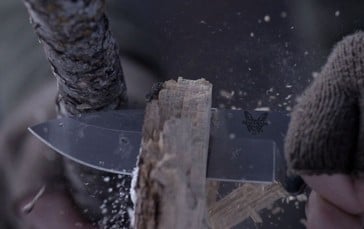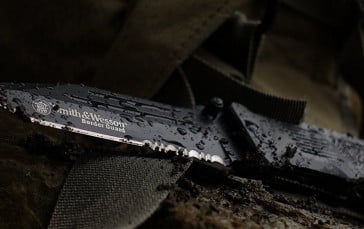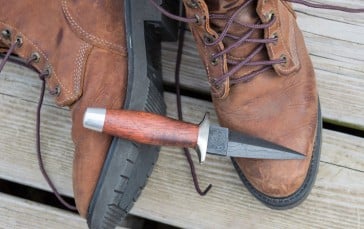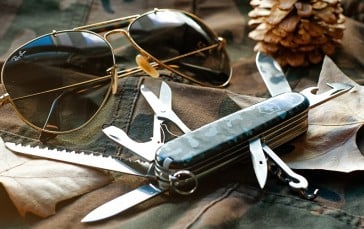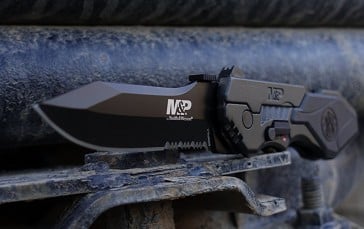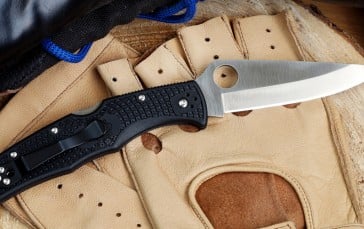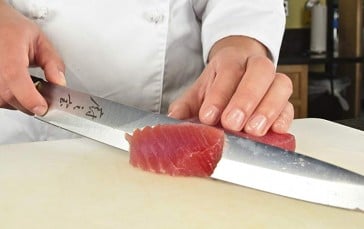Best Survival Knives in 2022
If you spend any time in the great outdoors camping, fishing, hunting or mountaineering you know that in a matter of just a few minutes a pleasant afternoon can turn into a survival situation when foul weather descends, temperatures drop and you’re miles from your camp or the nearest fixed shelter. In cases like that it’s crucial you have a first-class survival knife in your pocket or hanging from your belt. People die from hypothermia and suffer frostbite and trench foot in the thousands each year, so it’s no exaggeration to say that a survival knife can be just that: the means of your survival. The difference between life and death.
Some of the ways a survival knife can save your bacon in desperate situations include:
A survival knife then is not simply a piece of ‘gear jewelry’ that aspiring outdoorsmen wear to send mating signals, it’s likely the most important thing you carry into the outdoors with you other than food and water. In this survival knife guide we’re going to take a look at the 12 best survival knives as determined by our product review experts, several of whom are avid outdoor types themselves.
The Best Survival Knife
1Kershaw Ken Onion Survival Knife

The Kershaw Blur has a modestly sized recurved blade with SpeedSafe assisted opening that can be brought to bear on the task quick and easy. It’s one of only 2 folding survival knives on our list and earned its spot by way of that Sandvik, DLC-coated, corrosion resistant, stainless steel blade, light weight, reversible pocket clip, one-handed opening and affordability.
The handle of the Blur survival knife is tough, aircraft grade aluminum that has Trac-Tec inserts that allow for a deceptively solid grip. The blade opens quickly and quietly thanks to the built in, one-handed SpeedSafe mechanism and the pocket clip is fully reversible allowing you to decide whether to carry the Blur tip up or tip down. Beyond all that the Blur brings extreme portability to the table. It’s a trim 4 ½” long when closed so it will fit neatly into any of your pockets (one less thing to get hooked on branches and bushes). We’d take the Blur survival pocket knife (see guide) with us into any outdoor situation without hesitation.
2Fallkniven A1 Survival Knife

The Fallkniven A1 Survival Knife is a serious piece of survival gear intended for heavy duty applications but nimble enough for things like cleaning your catch. The laminated VG10 stainless steel used to make the 6 ⅜” blade is professional cutlery grade steel that’s hard but durable and will stand up to rigors of emergency use in atypical situations.
Don’t let the civilized look and feel of the A1 Survival Knife fool you. If the time comes when you have to chop branches to make an emergency shelter it will be there to answer the call without flinching. The full tang which peeks out the end of the handle can be used to break glass in emergencies and also ensures the blade isn’t going to separate just because you’re leaning into it a bit. Overall the knife is extraordinarily well balanced, can be honed to a razor sharp edge and the handle is equally comfortable in cold weather or hot. Who knows, you might even be able to make sushi with it. You’ll pay more but you’ll get more with the A1. Our handy guide to top Karambit Knives features more great items like this.
3Gerber Prodigy Survival Knife

The Prodigy features a 4 ¾” high carbon stainless steel blade with full tang and black oxide coating. The textured soft-grip with generous flange ensures you’ll never experience a catastrophic slip when you’re working the knife hard and its relatively compact size means you’ll have multiple carry options.
That oxide coating on the high carbon blade makes it better able to resist the corrosion that can typically befall this type of steel. And while we’re on the blade, it has a serrated edge that can be the difference between surviving and succumbing to the elements as it will hasten the harvesting of materials for creating your emergency shelter. Overall the knife is exceedingly well-balanced and has the feel of a larger knife. It’s also MOLLE (Modular Lightweight Load-carrying Equipment) compatible and comes with various attachment straps including a leg strap for superior versatility. A great all-around survival knife for relatively short money.
4Ka-Bar BK7

The Ka-Bar BK7 Combat survival knife was designed for soldiers in the field who require a knife that for cutting, prying, hacking, carving stakes, defending themselves and more. It features a 1095 Cro-Van steel blade that’s a full 7” long and a Grivory handle of hybrid glass-filled nylon fiber that allows for a superior grip in all conditions.
The full tang chromium vanadium steel blade maintains its edge well and sharpens easily when necessary. It sports a textured thumb rest for an easier hold and more precise control that extends from the blade end of the Swiss made Grivory handle. The overall length of the knife is a healthy 12 ¾” so you won’t be carrying this in your pocket, but you will be making would-be assailants think twice when you whip it out. This is not-to-be-messed-with survival gear for soldiers and adventurers and considering the affordable price you need to give it serious consideration.
5Gerber LMF II

The Gerber LMF II Survival Knife is the kind of compact monster that winds up being the most valuable player in your survival kit. If all you carried was it and a roll of duct tape you could probably survive for months in the wild. This knife has garnered widespread praise and for good reason; it’s perfectly balanced, easy to carry, durable as the day is long and razor sharp.
The LMF II survival knife will saw branches for your emergency shelter, allow you to break the window of an overturned car to extricate yourself or others, slice through a seat belt like a hot knife through butter (if you or one of those others is trapped) or make a spear to catch fish. It’s MOLLE compliant for service members, and the overmolded handle will let you retain your grip regardless of what’s falling from the sky or the conditions on the ground. The included sheath has a built in sharpener so if you dull the blade creating your shelter you can sharpen it right back up again. A beautiful, extremely handy and rugged piece of survival gear at a very reasonable price.
6Condor CTK232

The Condor CTK232 is a classic looking full tang walnut handled survival knife with a timeless look and timely effectiveness. The company that makes it has been producing high-end military bladed weaponry for hundreds of years and also produces some of the most sought after civilian cutlery in the world.
You could be forgiven for thinking you’ve seen this knife in a kitchen somewhere because it has a domestic quality about it that’s unmistakable. Upon closer inspection though you realize this survival knife was not created to slice onions on the chopping board but rather to skin rabbits, harvest firewood and carve tent stakes among myriad other outdoor applications. It’s simple, solid as a rock, comes with a nice leather sheath and the walnut handle makes for one of the most comfortable knives you’ve ever held. You can even chop onions with it if you really want. Overall an impressive survival knife from the classical school of knife making.
7Ontario 499

This knife has a throwback look because it’s a genuine throwback knife. It’s been part of the survival kit of US pilots for decades, designed to give them a fighting chance if they need to bail over hostile territory. With its distinctive handle, long serrated edge and industrial age design cues it’s both fascinating and effective.
Make no mistake, the Ontario 499 Survival Knife is no mere curiosity. It’s high value survival kit you’ll find yourself reaching for nearly as often as the water bottle. The knife exhibits near perfect balance, the 5” blade is treated with a corrosion resistant coating of zinc phosphate, there’s a sharpening stone included (with pocket on the leather sheath) so you’re never left with a dull blade and the butt end can be used to hammer down tent stakes and the like. There’s an old school approach at work here to be sure, but it works. And then some.
8Schrade SCHF9

The Schrade SCHF9 Extreme Survival Knife sports a high carbon 1095 stainless steel full tang blade that’s an impressive 6 ½” long. Whether you need to clean fish, skin an elk, carve tent stakes, cut bandages or free someone trapped by their safety belt the SCHF9 Extreme Survival Knife will answer the call.
At more than a foot in overall length the SCHF9 survival knife cuts a formidable profile. It might be a bit unwieldy for smaller folks but for larger outdoor types it’s going to feel comfy and reassuring. The design ensures that force is projected toward the blade; a valuable ergonomic touch that’s easy to overlook. While the carrying sheath is nothing special you’re not purchasing this knife for the carrying sheath. You’re purchasing it to enable your outdoor adventures and maybe extricate yourself from life threatening situations. And it will do those things brilliantly for short money.
9Gerber Freeman Guide

Our final survival knife is also our fourth Gerber entry and one that lovers of the survival pocket knife are sure to appreciate. The Freeman Guide Folding Knife is built to exacting tolerances, tucks neatly into your pocket, opens with silent urgency and performs whatever survival-related task you ask of it from cutting a branch to carving a spear to cleaning the fish you catch with that spear.
Gerber packs a lot to like into their modestly sized survival knife including a blade that’s just over 3 ½” long, one handed opening of that blade, a supremely comfortable handle with TacHide for a sure grip regardless of the weather and a butt end you can use to break any glass that may be standing between you and survival. It’s light weight, brilliantly engineered and costs about the same as a large pizza. An astonishing deal on a survival knife you’ll carry with you for years.
Survival Knives Buyer Guide and FAQs
Things To Consider When Buying A Survival Knife
There are many things to consider when looking for the best survival knife including everything from the weight, the ease of use, the style, or the blade type. More importantly, though, is the material, length, and thickness of the blade.
The survival knife is a highly versatile tool, and different designs can assist in different situations. Before you make your final decision, look at our quick and handy little guide to these key features for survival knives.
Size – Size may not matter to some people in some circumstances but as far as a survival knife is concerned a 2 or 3” blade isn’t going to be of much help when you’re trying to harvest wood to build an emergency shelter. To be sure your survival knife doesn’t have to have a foot long blade and be seething with destructive possibility but any blade shorter than 4” is just not going to cut it as a viable survival knife. Ideally we’d like a blade somewhere between 4 ½” and 5 ½”.
Fixed Blade or Folder – When it comes to knives any type of joint or hinge is a potential weak point and a survival knife without a full tang will be practically useless for prying things open. So there’s no doubt that a fixed blade with full tang will be more durable and hold up to greater levels of use and abuse than a folding survival knife. At the same time however there’s something to be said for being able to carry your knife comfortably in a pocket rather than on your belt or leg. Still, if it were our decision we’d go with the fixed blade.
Tang – No we’re not talking about the powdered drink but about knife construction. When it comes to a survival knife a “full tang” means the metal of the blade extends all the way through to the butt end of the handle in one continuous piece. The grip is then fashioned around the butt end of the metal. In this way there are no issues of the blade coming loose or breaking free of the handle and the survival knife will last longer as a result. Partial tang knife blades should be avoided as they’ll eventually begin to loosen and become dangerous to use. If you have a choice always choose full tang.
Pointed Tip – You may have noticed while shopping for a survival knife that some seem to have a point on the end of the blade, and we don’t just mean that it’s sharp. We mean an actual point protruding from the end of the blade. Some people swear by pointed tips while others see them as being of little value and even representing an unnecessary danger. So who’s right? In this case we’d come down on the side of the point which can be put to a variety of uses including cleaning fish more effectively, drilling or notching items you want to join, removing splinters, gear repair and more.
The Pommel or Butt – A survival knife is all about efficiency and effectiveness so the butt end of the handle should be put to some effective use or else it’s simply wasted space. In many cases the pommel contains a solid, machined form that’s designed to break glass in case you’re ever trapped behind a closed window. This hard, finished end also doubles as a self-defense tool, allowing you to use both ends of the survival knife to defend yourself. In the case of the Ontario 499 reviewed above the pommel is deliberately shaped like a hammer so you can use it as such.
Handle – The handle on a survival knife needs to provide a sure grip in all weather conditions. The world doesn’t care if you’re in trouble and will often greet your distress with pounding rain, driving snow and either scorching or bone numbing temperatures. Regardless, you need to be able to retain a solid grip on your knife so you can continue to build your shelter, harvest wood and get a fire going. Keep in mind that if a knife has a hollow handle for storing things like matches it can’t have a full tang. Also avoid any extras attached to the handle that could interfere with your grip.
Blade Shape – Most people who’ve never owned or used a survival knife come to the process of buying one totally unaware that there are different shapes to survival blades. Popular blade types are drop point blades and clip point blades along with serrated edges for sawing and hacking. A drop point blade has a wide tip that buttresses the blade’s structural integrity while a clip point blade typically has a narrower point which is better for piercing or stabbing but is more susceptible to breaking off if you use it to pry things open. The serrated edge – either partial or full length – is non-negotiable as far as many people are concerned.
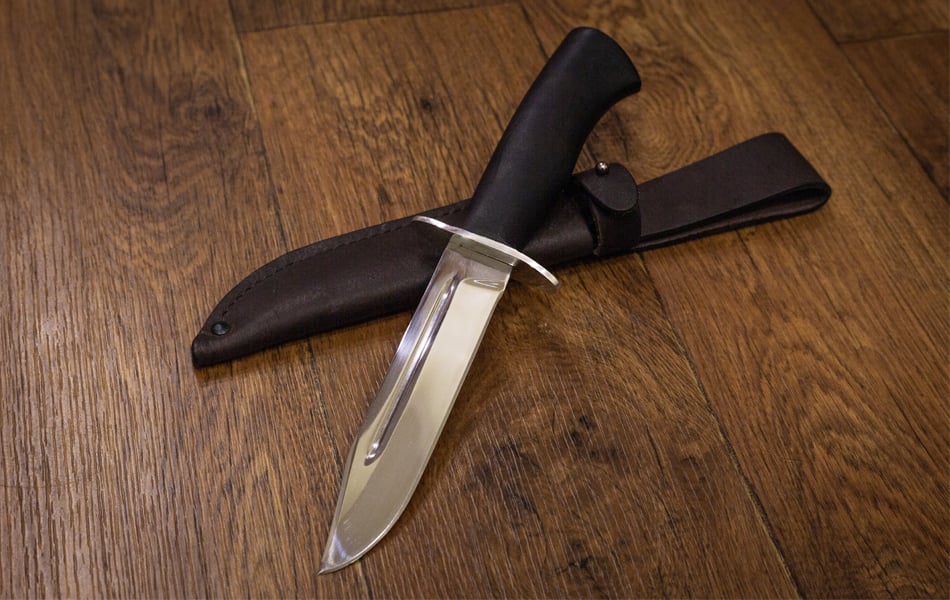
Sheath – You need a practical means of transporting your survival knife and that’s particularly true if it is large and has a fixed blade like most do. Enter the sheath. Most every day carry fixed blade survival knife comes with a sheath though many are just perfunctory creations. The bottom line is that there are a few things you’ll want present in your sheath including the lanyard attachment, belt loop, secure closing strap and a leg attachment so that you can strap a larger knife to your leg if you wish. It’s also a good idea to get a sheath with a small pocket for a sharpening stone, in case you dull the survival knife cutting firewood or some other way.
In addition, there are a number of other features of varying degrees of importance that you may want to consider when shopping for your new survival knife. These include any type of finish on the blade, the color of the handle, the type of steel used for the blade (high carbon or stainless), the presence of a blood groove on the blade, finger guards, any decorative touches and more.
Blade Material - When looking for your new survival knife, you’ll find they are made from two types of steel.
Stainless Steel - It’s tough, it’s durable, and it’s long-lasting. Considered virtually indestructible, stainless steel won’t rust after experiencing a single torrential downpour so you can ensure it performs well for as long as you need.
However, while they are excellent, and it’s not as if you’d be missing anything out if you picked a stainless steel knife, the blade dulls faster when compared to carbon steel. This depends on how often you use it and how well you take care of it, though, so if you stay on top of your stainless steel knife care, this shouldn’t be an issue.
Carbon Steel - Likewise, a carbon steel blade holds the edge much longer than a stainless steel blade does, which means you need not bring a sharpener with you when undertaking long treks into the wilderness. It’s not the perfect blade, however, and while it holds an edge better and for longer, it isn’t as durable when exposed to extreme elements, leading to premature rusting if you compared it to stainless steel.
Blade Length - The survival knife you choose will have a blade measuring between 6 and 12 inches, and that’s not counting the length of the handle. Survivalists consider this the optimal length for excellent performance while still being properly weighted. While larger knives may look a little to 80s Action Hero, they still serve a purpose, and they are more convenient to carry than a hatchet.
The right blade length is essential to being able to do all the survival things you need to do such as chop wood, cut twine, shave bark from branches to make yourself a cool caveman-style spear, and prepare your dinner for another night surrounded by trees, darkness, and curious critters who may or may not consider you dinner for themselves.
Blade Thickness - If you’re not a knife expert, you might wonder why the blade thickness matters at all? Well, imagine if you need to chop some wood to build a fire or mark a notch on a tree just in case you get lost, would a thin and flimsy blade do the trick? We’re thinking no. In fact, we know the answer is a resounding no.
A thick blade will prove much more durable, allowing you to chop and slice whatever you need. It will be capable of handling years of abuse and be reliable regardless of what you demand of it. For optimal results, thicknesses between 3/16 - 4/16 of an inch are perfect, being neither too thin nor too thick.
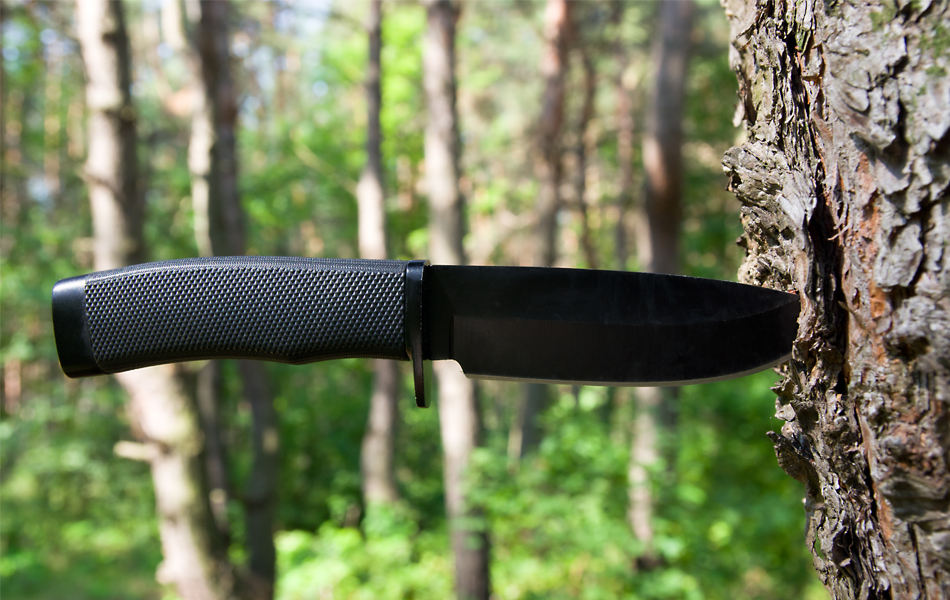
Survival Knife FAQ
Q: What Is A Survival Knife?
A: A survival knife is intended primarily to assist individuals who find themselves in survival situations in the wild. Perhaps they’ve become separated from their group or unit. Perhaps they’ve been caught far from shelter when bad weather closed in or perhaps they injured themselves backpacking and need to cut bandages and create a shelter and fire while they await rescue. Of course, there are many more prosaic uses for a survival knife like carving tent stakes, cleaning fish, prying things apart or cutting wood for a fire.
Q: Who Has Use For A Survival Knife?
A: Soldiers, hunters, backpackers, mountaineers, casual campers, rescue personnel, rangers and all manner of sports enthusiast commonly employ the survival knife in the performance of their duties, as part of their activities or to extricate themselves from life-threatening situations. You’ll often see carpenters, house framers and other craftsmen and women with a survival knife hanging from their belt.
Q: Is It Legal To Carry A Survival Knife?
A: Knife laws vary from state to state, county to county and city to city. In most places, knife laws are designed to discourage carrying a knife in a concealed fashion. In rural areas, however, knife laws are typically far more relaxed so carrying a survival knife into the woods should not present a problem, unless you’re talking a national park. Even then, any regulations are likely to be aimed at discouraging large, concealed knives. Be sure to check with the laws regarding open carry where you live before going out with your survival knife.
Q: Who Makes The Best Survival Knife?
A: There are many manufacturers of high-quality survival knives as the above list should indicate. As such one person’s “best survival knife” manufacturer is likely to differ from another person’s and who’s to say who is right? We’d state with confidence that all of the companies that produced the knives on this list are experienced manufacturers of high-quality knives.
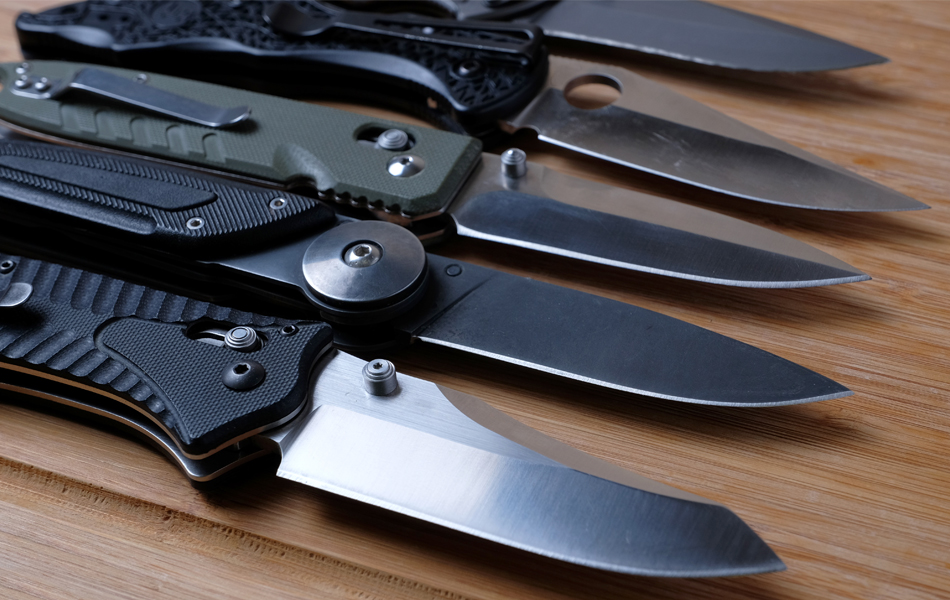
Q: How To Care For A Survival Knife?
A: You want your knife to last as long as it can. This isn’t only because a longer-lasting knife will save you money investing a replacement, but also because, as humans, we become weirdly attached to inanimate objects (and sometimes conceptual ones, too) and it can be hard to say goodbye.
To ensure your knife lasts as long as it can and you get ample use from it, you need to take care of it, so here are the key tips for caring for your survival knife.
Keep it clean - Keeping your blade clean will increase its lifespan and help it maintain excellent quality. This will also prevent a buildup of potentially harmful bacteria it may have picked up. To keep it clean, use a soap and running water to give it a thorough clean over both blade and handle. This will remove sap and dirt, and to prevent early rusting, make sure it is dry before putting it back in the sheath.
You don’t need to vigorously clean it all the time, but giving it a wipe down before putting it back into the sheath will keep it great condition.
Keep it oiled - Oiling the blade prevents friction and allows it to slide in and out of the sheath more easily. You can use standard household oils and lubricants, but remember to only use a small amount as you could end up with oil all over your fingers, which seems to us like it would be an easy way to hurt yourself.
Keep it sharp - We’ll go into the details of how to keep your knife sharp below, but a blunt knife is pretty much useless in survival situations and is actually more dangerous to you than a sharp one is. Dull knives require more pressure and force to complete tasks, making it more difficult to control and also causing fatigue.
Keep it high and dry - For both safety and longevity reasons, you must find somewhere dry and out of the way to store your knife. The dryness prevents potential moisture that could damage the blade, while the height ensures curious kids can’t get their hands on it and hurt themselves or others.
Q: How To Sharpen A Survival Knife?
There are three ways to sharpen your survival knife:
Whetstone - Keep the stone wet and brush the knife over the surface to regain the edge. Once you’ve gotten the edge back, you can use finer stones to make it as sharp as you desire.
Ceramic - More convenient and portable is the ceramic stone, which is a commercial product that sharpens both edges at the same time as you run the blade through the channels.
Diamond - A long rod-type device, these are best for using at home. Simple and straightforward, you run the blade up and down the rod until you achieve the sharpness you need.
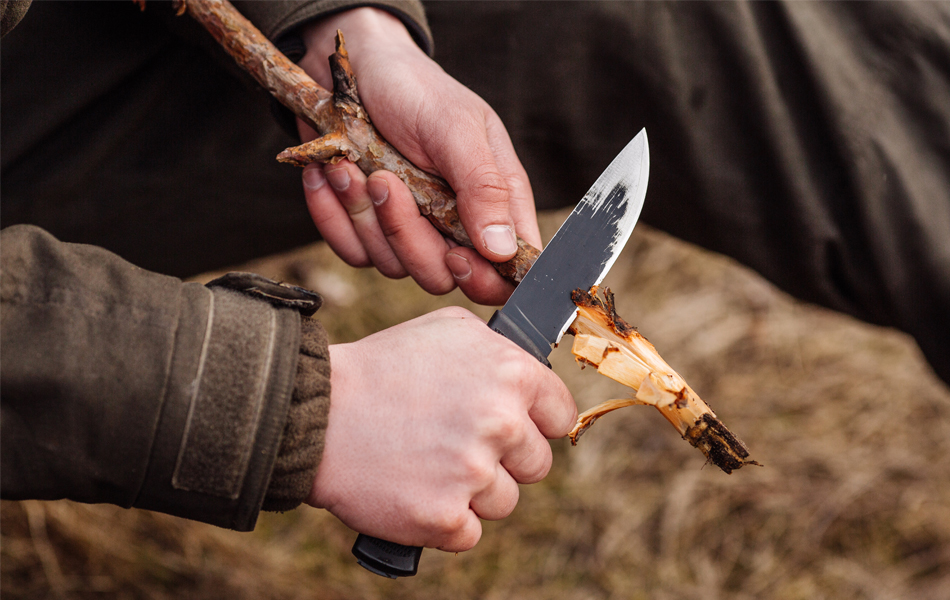
Conclusion
The survival knife isn’t as glamorous as a hunting GPS system, a handheld outdoor espresso maker or digital HD recording binoculars. But when you’re stumbling through the wilderness after injuring yourself in a fall and there’s no shelter in sight, the snow is blowing in your face and night is falling you’ll need it to build a shelter, gather wood, start a fire, cut bandages and open those emergency canned goods you brought along just in case. When it’s time to begin looking for a survival knife keep the above reviews and tips in mind and you’re bound to wind up with the right knife at the right price.
We hope you found these survival knife reviews useful and don’t forget to check back regularly for more insightful product reviews from your friends at GearHungry.
